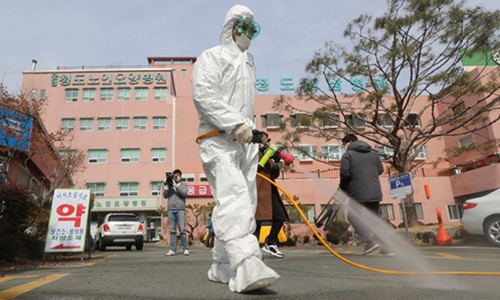HOME >> OPINION
Some countries slow to respond to virus
Source:Global Times Published: 2020/2/23 23:43:40

A South Korean health official sprays disinfectant in front of a hospital where a total of 16 infections of COVID-19 have been reported, in Cheongdo county near the city of Daegu on Friday. The total number of infections in South Korea rose to 602 as of 10 pm Sunday. Photo: AFP
The outbreak of novel coronavirus (COVID-19) is breaking through the globe's epidemic prevention system. The risk of the epidemic spreading out of control worldwide is increasing. Apart from China, the worst-affected countries, for the moment, are Japan, South Korea, Iran and Italy. The population size of each of these countries is roughly equivalent to that of a province in China. The situation in these countries, if compared with Chinese provinces other than Hubei, is already serious.
These countries are now paying growing attention to the risks posed by the epidemic and have taken some measures. For example, South Korea has postponed the new school year, Italy has locked down some towns where the epidemic situation is severe. Some Serie A matches in Italy were suspended. Iran has canceled all art and cinema events until the end of the week.
Yet it is worrisome that the prevention and control measures adopted by the above-mentioned countries might be insufficient. The situation in China has shown that the virus is extremely contagious: It can easily spread in public places and in communities. It is either hard from the beginning or becoming hard now for people to observe where and by what means the COVID-19 is spreading in those countries. Perhaps the virus has been spreading in an invisible way in recent days.
In Wuhan, capital of Hubei Province, it took only a few weeks from people realizing the severity of the epidemic to the situation in which the virus spread in an uncontrollable way. Fortunately, China has a huge medical system and can quickly mobilize over 40,000 medical staff to support Wuhan and Hubei. If a second epicenter like Wuhan were to emerge in another country, it is difficult to imagine that such massive assistance could be mobilized.
Moreover, the epidemic in other countries might not have been fully monitored. It is possible that some COVID-19 cases in certain countries have been treated simply as patients with a bad cold. In the US, the numbers of people infected and killed in this flu season are particularly large. Japan's TV Asahi even raised a bold speculation, saying that many flu deaths in the US might have in fact resulted from COVID-19.
Hopefully no country will share the fate of Wuhan. The incubation period of COVID-19 can be deceptive. In countries where the situation is already serious, there must be more determined measures to stop the undetected spread which may be underway. If these countries take measures before the spread, then they will have more initiative.
Faced with the risk of the global spread of the COVID-19, countries that are not yet severely hit by the epidemic should also take precautions, including strengthening the capability of detecting infected people, expanding the production and storage of medical supplies to enable infection prevention and control, such as surgical masks and protective outfits.
The epidemic has not yet taken a turn for the better in China, but we have gone through the most difficult period. In places outside of Hubei Province, while people are still making great efforts in preventing the epidemic, work and production are also resuming. In the fight against the virus, China has provided lessons and contributed valuable experience, which can be a reference for other countries worldwide.
RELATED ARTICLES:
Posted in: EDITORIAL